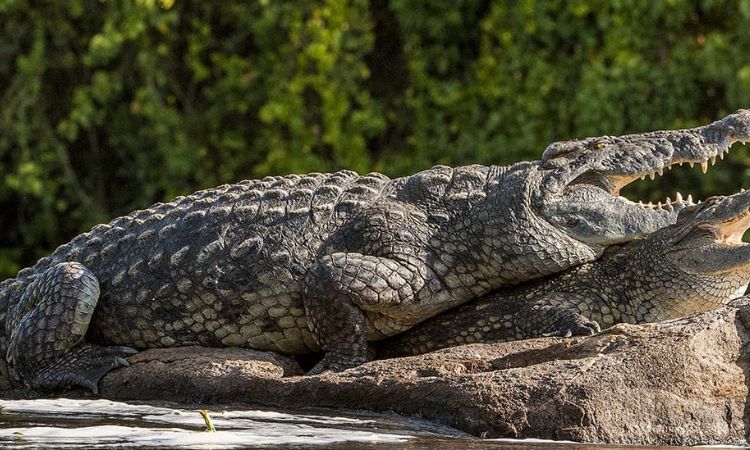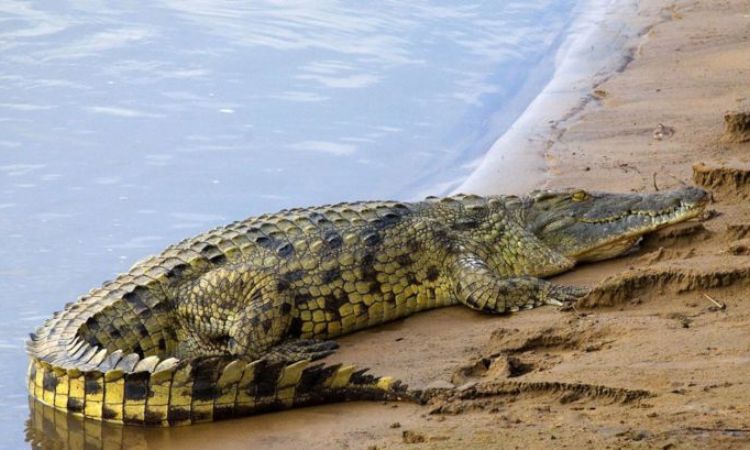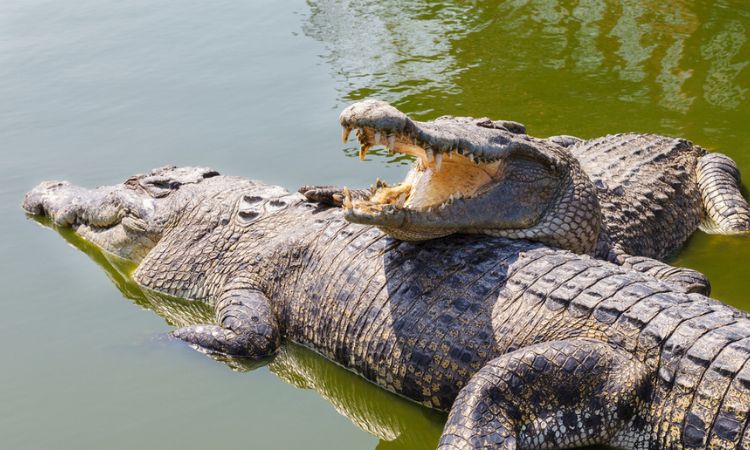Nile Crocodile – Size, Habitat, Bite Force,& 5 Amazing Facts
Nile Crocodile: Discover the Nile crocodile’s size, lifespan, population, bite force, and fascinating facts. Learn where to find Nile crocodiles in Uganda and across Africa.
Introduction
The Nile crocodile (Crocodylus niloticus) reigns as Africa’s most feared predator, a formidable reptile that commands respect in the rivers, lakes, and swamps of sub-Saharan Africa.
Known for its massive Nile crocodile size, bone-crushing bite force, and stealthy ambush tactics, this apex predator captivates wildlife enthusiasts and researchers alike.
From the murky waters of Uganda’s Nile River to the sprawling wetlands of Tanzania, the Nile crocodile thrives in diverse habitats.
In this comprehensive guide, we explore the Nile crocodile population, lifespan, behavior, and where to spot these incredible creatures, including prime locations like Nile crocodile Uganda.
Nile Crocodile Size, Mass, and Height
The Nile crocodile size is awe-inspiring, making it one of the largest reptiles on Earth. Adult males typically measure between 3.5–5 meters (11–16 feet) in length, while females are slightly smaller, averaging 2.4–4 meters.
Their Nile crocodile mass ranges from 225–750 kg (500–1,650 lbs) for males, with females weighing less. Juveniles start small, hatching at about 30 cm, but grow rapidly under favorable conditions.
The biggest Nile crocodile ever recorded pushes the limits of size, with some individuals reaching up to 6 meters and weighing over 900 kg. These giants are rare but highlight the species’ potential for massive growth.
Unlike height in mammals, crocodiles are measured by length, as they remain low to the ground, perfectly adapted for their aquatic lifestyle.

Biggest Nile Crocodile Ever Recorded
Legends of enormous Nile crocodiles abound, but one stands out: Gustave, a infamous crocodile from Burundi. Estimated at 6 meters and over 900 kg, Gustave is considered the biggest Nile crocodile in history. This elusive giant has reportedly evaded capture for decades, gaining a mythical status.
Sightings of massive crocodiles in Uganda and Tanzania fuel similar tales, though few are confirmed. These giants showcase the Nile crocodile’s potential to grow to extraordinary sizes under ideal conditions.
Nile Crocodile Location & Habitat
The Nile crocodile location spans sub-Saharan Africa, from Egypt’s Nile River to South Africa’s coastal wetlands. They thrive in Nile crocodile habitats like rivers, lakes, swamps, and estuaries.
In Uganda, prime spots include Lake Victoria, the Nile River, Murchison Falls National Park, and Queen Elizabeth National Park, where crocodiles bask along riverbanks or lurk beneath the surface.
Their adaptability to freshwater ecosystems makes them widespread, with populations in Kenya, Tanzania, Zambia, and beyond. Nile crocodiles prefer warm, slow-moving waters but can tolerate brackish environments, showcasing their resilience.
Nile Crocodile vs Saltwater Crocodile
The Nile crocodile vs saltwater crocodile debate is a favorite among wildlife enthusiasts. While both are formidable, they differ in key ways. The saltwater crocodile (Crocodylus porosus) is slightly larger, averaging 4–6 meters and weighing 400–1,000 kg.
However, the Nile crocodile holds its own as Africa’s largest crocodilian, with a bite force of around 5,000 psi, rivaling or surpassing the saltwater crocodile’s 3,700–5,000 psi.
|
Feature |
Nile Crocodile |
Saltwater Crocodile |
|
Average Length |
3.5–5 m |
4–6 m |
|
Weight |
225–750 kg |
400–1,000 kg |
|
Bite Force |
5,000 psi |
3,700–5,000 psi |
|
Habitat |
Rivers & lakes (Africa) |
Estuaries & coasts (Asia-Pacific) |
While saltwater crocodiles roam coastal waters, Nile crocodiles dominate inland waterways, making them Africa’s apex aquatic predator.
Nile Crocodile Bite Force
The Nile crocodile bite force is among the strongest in the animal kingdom, measuring around 5,000 pounds per square inch (psi).
This dwarfs the bite of a lion (650 psi) and a human (160 psi), earning it the title of strongest jaws in Africa. This immense power allows Nile crocodiles to crush bones and subdue large prey like wildebeest, zebra, and even buffalo. Their conical teeth are designed for gripping, not chewing, ensuring prey cannot escape.

Nile Crocodile Population & Age
The Nile crocodile population is estimated at 250,000–500,000 individuals across Africa, classified as Least Concern by the IUCN.
However, local threats like habitat loss, poaching, and human-wildlife conflict endanger some populations. In Uganda, conservation efforts in national parks help maintain stable numbers.
The Nile crocodile lifespan is impressive, with individuals living 70–100 years in the wild. Their longevity, combined with low predation rates as adults, ensures their dominance in their ecosystems.
Nile Monitor Connection
The Nile monitor (Varanus niloticus), a large lizard, often shares habitats with Nile crocodiles. These reptiles are sometimes mistaken for juvenile crocodiles due to their similar coloration and aquatic habits.
While Nile monitors scavenge crocodile eggs or prey on hatchlings, they coexist cautiously, with adult crocodiles occasionally preying on monitors.
The Nile crocodile and Nile monitor relationship highlights the complex dynamics of African freshwater ecosystems.
Behavior & Aggression
Are Nile crocodiles aggressive? Absolutely. Nile crocodiles are highly territorial, especially during mating season or when guarding nests. Their Nile crocodile behavior includes stealthy ambush tactics, where they submerge and strike with lightning speed.
Responsible for most crocodile attacks in Africa, they pose a significant risk to humans near waterways. Their aggression, paired with their strength, makes them one of nature’s most formidable predators.
Diet — Who Eats Nile Crocodiles?
As apex predators, adult Nile crocodiles face few natural threats. Their Nile crocodile diet includes fish, birds, antelope, and occasionally larger prey like buffalo. However, young crocodiles are vulnerable, eaten by Nile monitors, large fish, birds like herons, and even larger crocodiles.
Rarely, big cats like lions may target juveniles. Humans are the primary threat to adults, through hunting or habitat destruction. Who eats Nile crocodiles? Mostly their own kind or opportunistic predators preying on the young.
Interesting Facts About the Nile Crocodile
- Long Submersion: Nile crocodiles can hold their breath for up to 2 hours underwater, aiding their stealthy hunting.
- Protective Mothers: Female crocodiles fiercely guard their nests, carrying hatchlings to water in their mouths.
- Surprising Speed: They can sprint up to 17 km/h on land in short bursts, catching prey off guard.
- Jaw Strength: Their powerful jaws can crush bones, yet can be held shut with simple tape due to weak opening muscles.
- Stone Swallowing: Crocodiles swallow stones (gastroliths) to aid digestion and buoyancy control.
These facts about Nile crocodile behaviors highlight their unique adaptations and survival strategies.
FAQ about Nile Crocodiles
What are 5 interesting facts about the Nile crocodile?
They can hold their breath for 2 hours, females guard nests fiercely, they sprint up to 17 km/h, their jaws crush bones but are easily restrained, and they swallow stones for digestion.
Are Nile crocodiles aggressive?
Yes, they are highly territorial and responsible for most crocodile attacks in Africa.
How strong is a Nile crocodile’s bite?
Their bite force is around 5,000 psi, among the strongest in the animal kingdom.
What eats Nile crocodiles?
Young crocodiles are eaten by monitors, birds, and larger crocs; adults face few predators except humans.
Where can I see Nile crocodiles in Uganda?
Visit Murchison Falls National Park, Queen Elizabeth National Park, Lake Victoria, or the Nile River for prime sightings.
Conservation & Importance
Nile crocodiles play a vital role in their ecosystems, controlling fish populations and scavenging carrion, which maintains waterway health. Nile crocodile conservation efforts in Uganda and other African countries focus on protecting habitats and reducing human-wildlife conflict.
Organizations like the IUCN monitor their status, ensuring their survival. The importance of Nile crocodiles extends beyond ecology, as they draw tourists to parks, boosting local economies.
In Conclusion, The Nile crocodile is a marvel of nature, combining immense size, unparalleled bite force, and a vital ecological role.
From the rivers of Uganda to the wetlands of Tanzania, these predators captivate and command respect. By supporting conservation efforts and engaging in responsible wildlife viewing, we can ensure the Nile crocodile continues to thrive.
Plan a visit to Murchison Falls or explore Uganda wildlife safaris with us today to witness these incredible creatures in their natural habitat.
